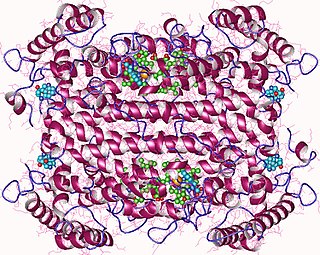Sex differences in medicine include sex-specific diseases or conditions which occur only in people of one sex due to underlying biological factors ; sex-related diseases, which are diseases that are more common to one sex ; and diseases which occur at similar rates in males and females but manifest differently according to sex.

The Philadelphia chromosome or Philadelphia translocation (Ph) is a specific genetic abnormality in chromosome 22 of leukemia cancer cells. This chromosome is defective and unusually short because of reciprocal translocation, t(9;22)(q34;q11), of genetic material between chromosome 9 and chromosome 22, and contains a fusion gene called BCR-ABL1. This gene is the ABL1 gene of chromosome 9 juxtaposed onto the breakpoint cluster region BCR gene of chromosome 22, coding for a hybrid protein: a tyrosine kinase signaling protein that is "always on", causing the cell to divide uncontrollably by interrupting the stability of the genome and impairing various signaling pathways governing the cell cycle.
The Institute of Cancer Research is a public research institute and a member institution of the University of London in London, United Kingdom, specialising in oncology. It was founded in 1909 as a research department of the Royal Marsden Hospital and joined the University of London in 2003. It has been responsible for a number of breakthrough discoveries, including that the basic cause of cancer is damage to DNA.
Fox Chase Cancer Center is a National Cancer Institute-designated Comprehensive Cancer Center research facility and hospital located in the Fox Chase section of Philadelphia, Pennsylvania, United States. The main facilities of the center are located on property adjoining Burholme Park. The center is part of the Temple University Health System (TUHS) and specializes in the treatment and prevention of cancer.

Lankenau Medical Center, part of Main Line Health, is a 370-bed acute care, teaching hospital in Wynnewood, Pennsylvania.

Medical genetics is the branch of medicine that involves the diagnosis and management of hereditary disorders. Medical genetics differs from human genetics in that human genetics is a field of scientific research that may or may not apply to medicine, while medical genetics refers to the application of genetics to medical care. For example, research on the causes and inheritance of genetic disorders would be considered within both human genetics and medical genetics, while the diagnosis, management, and counselling people with genetic disorders would be considered part of medical genetics.

l-Kynurenine is a metabolite of the amino acid l-tryptophan used in the production of niacin.

Ellen Heber-Katz is an American immunologist and regeneration biologist who works as a professor at Lankenau Institute for Medical Research (LIMR). She discovered that the Murphy Roths Large (MRL) mouse strain can regenerate wounds without scarring and fully restore damaged tissue. Her research focuses on immunology, regenerative medicine, and cancer. In July 2015, she expanded her research to include studies funded by the National Cancer Institute (NCI) that investigate novel aspects of breast cancer causation.

Indoleamine-pyrrole 2,3-dioxygenase (IDO or INDO EC 1.13.11.52) is a heme-containing enzyme physiologically expressed in a number of tissues and cells, such as the small intestine, lungs, female genital tract or placenta. In humans is encoded by the IDO1 gene. IDO is involved in tryptophan metabolism. It is one of three enzymes that catalyze the first and rate-limiting step in the kynurenine pathway, the O2-dependent oxidation of L-tryptophan to N-formylkynurenine, the others being indolamine-2,3-dioxygenase 2 (IDO2) and tryptophan 2,3-dioxygenase (TDO). IDO is an important part of the immune system and plays a part in natural defense against various pathogens. It is produced by the cells in response to inflammation and has an immunosuppressive function because of its ability to limit T-cell function and engage mechanisms of immune tolerance. Emerging evidence suggests that IDO becomes activated during tumor development, helping malignant cells escape eradication by the immune system. Expression of IDO has been described in a number of types of cancer, such as acute myeloid leukemia, ovarian cancer or colorectal cancer. IDO is part of the malignant transformation process and plays a key role in suppressing the anti-tumor immune response in the body, so inhibiting it could increase the effect of chemotherapy as well as other immunotherapeutic protocols. Furthermore, there is data implicating a role for IDO1 in the modulation of vascular tone in conditions of inflammation via a novel pathway involving singlet oxygen.

In enzymology, tryptophan 2,3-dioxygenase (EC 1.13.11.11) is a heme enzyme that catalyzes the oxidation of L-tryptophan (L-Trp) to N-formyl-L-kynurenine, as the first and rate-limiting step of the kynurenine pathway.
Chronic systemic inflammation (SI) is the result of release of pro-inflammatory cytokines from immune-related cells and the chronic activation of the innate immune system. It can contribute to the development or progression of certain conditions such as cardiovascular disease, cancer, diabetes mellitus, chronic kidney disease, non-alcoholic fatty liver disease, autoimmune and neurodegenerative disorders, and coronary heart disease.

The kynurenine pathway is a metabolic pathway leading to the production of nicotinamide adenine dinucleotide (NAD+). Metabolites involved in the kynurenine pathway include tryptophan, kynurenine, kynurenic acid, xanthurenic acid, quinolinic acid, and 3-hydroxykynurenine. The kynurenine pathway is responsible for about 95% of total tryptophan catabolism. Disruption in the pathway is associated with certain genetic and psychiatric disorders.

1-Methyltryptophan is a chemical compound that is an inhibitor of the tryptophan catabolic enzyme indoleamine 2,3-dioxygenase. It is a chiral compound that can exist as both D- and L-enantiomers.

George C. Prendergast is an American biomedical scientist. His research has focused on cancer pathobiology and immunology. Since 2004, he has been the president and CEO of Lankenau Institute for Medical Research, a cancer-focused research center in the U.S. He is also the co-director of the Program in Cancer Cell Biology & Signaling at the Sidney Kimmel Cancer Center, Thomas Jefferson University.

Epacadostat is an investigational drug for cancer. Epacadostat is an inhibitor of indoleamine 2,3-dioxygenase-1 (IDO1). Epacadostat inhibits IDO1 by competitively blocking it, without interfering with IDO2 or tryptophan 2,3-dioxygenase (TDO). It has antitumor activity in some models, though is most effective when combined with other immunotherapy agents.
Gan-Xin Yan is an American cardiologist, electrophysiologist and cardiovascular research scientist. His studies of arrhythmias have contributed to an understanding of J wave syndromes, long QT syndrome, and other abnormalities that can lead to sudden cardiac death. Yan is a professor at Lankenau Institute for Medical Research (LIMR) and a practicing cardiologist and electrophysiologist at Lankenau Medical Center, both located in Wynnewood, Pennsylvania. He also holds positions as professor of medicine at Sidney Kimmel Medical College of Thomas Jefferson University in Philadelphia and Xi'an Jiaotong University in Xi'an, Shaanxi, China.

Indoleamine 2,3-dioxygenase 2 (IDO2) is a protein that in humans is encoded by the IDO2 gene.
David A. Hungerford (1927–1993) was an American cancer researcher and co-discoverer of the Philadelphia chromosome. This discovery was the first association between a genetic abnormality and a type of cancer, and it changed the direction of cancer research and paved the way for the development of targeted cancer therapies.
Christine J. Harrison is a Professor of Childhood Cancer Cytogenetics at Newcastle University. She works on acute leukemia and used cytogenetics to optimise treatment protocols.

Linrodostat is an experimental drug being studied for its immunomodulating and antineoplastic activities.













